Computational Modeling of Extrasynaptic NMDA Receptors: Insights into Dendritic Signal Amplification Mechanisms
Abstract
:1. Introduction
2. Results
2.1. Separate and Combined Effects of Synaptic and Extrasynaptic Inputs
2.2. Effect of Latency between Synaptic and Extra-Synaptic Inputs
2.3. Analysis of the Influence of Synaptic Stimulation Frequency
2.4. Effect of Spatiotemporal Distribution of EPSPs on the Interaction with exNMDA
2.5. The Optimal Location of exNMDA
2.6. Effect of exNMDA Decay Time Constant on the Efficiency of Interaction with EPSPs
3. Discussion
3.1. Integrative Role of Dendritic Computation: Beyond Passive Conduction
3.2. The Origin of Glutamate for Activating exNMDA Amplification
3.3. Spatial Organization of exNMDA Amplifiers: Clustered versus Diffused Distribution
3.4. Methodological Challenges in Investigating exNMDA Mediated Signal Amplification
3.5. Hypothetical Role of exNMDA Clusters in Neurodegenerative Disorders
4. Materials and Methods
4.1. Modeling of Synaptic and Extrasynaptic Events
4.2. Synaptic AMPA Receptors
4.3. Synaptic NMDA Receptors
4.4. Computation of EPSP
4.5. Extra-Synaptic NMDA Receptors
4.6. Propagation of Signals along Dendrite
4.7. Key Model Parameters and Availability of Code
5. Conclusions
Author Contributions
Funding
Institutional Review Board Statement
Informed Consent Statement
Data Availability Statement
Conflicts of Interest
References
- Benke, T.; Traynelis, S.F. AMPA-type glutamate receptor conductance changes and plasticity: Still a lot of noise. Neurochem. Res. 2019, 44, 539–548. [Google Scholar] [CrossRef] [PubMed]
- Swanson, G.T.; Kamboj, S.K.; Cull-Candy, S.G. Single-channel properties of recombinant AMPA receptors depend on RNA editing, splice variation, and subunit composition. J. Neurosci. 1997, 17, 58–69. [Google Scholar] [CrossRef] [PubMed]
- Geiger, J.R.; Lübke, J.; Roth, A.; Frotscher, M.; Jonas, P. Submillisecond AMPA receptor-mediated signaling at a principal neuron–interneuron synapse. Neuron 1997, 18, 1009–1023. [Google Scholar] [CrossRef]
- Jonas, P.; Major, G.; Sakmann, B. Quantal components of unitary EPSCs at the mossy fibre synapse on CA3 pyramidal cells of rat hippocampus. J. Physiol. 1993, 472, 615–663. [Google Scholar] [CrossRef] [PubMed]
- Bellingham, M.C.; Lim, R.; Walmsley, B. Developmental changes in EPSC quantal size and quantal content at a central glutamatergic synapse in rat. J. Physiol. 1998, 511, 861–869. [Google Scholar] [CrossRef]
- Hestrin, S.; Sah, P.; Nicoll, R.A. Mechanisms generating the time course of dual component excitatory synaptic currents recorded in hippocampal slices. Neuron 1990, 5, 247–253. [Google Scholar] [CrossRef]
- Zhu, J.J. Maturation of layer 5 neocortical pyramidal neurons: Amplifying salient layer 1 and layer 4 inputs by Ca2+ action potentials in adult rat tuft dendrites. J. Physiol. 2000, 526, 571–587. [Google Scholar] [CrossRef] [PubMed]
- Fletcher, L.N.; Williams, S.R. Neocortical topology governs the dendritic integrative capacity of layer 5 pyramidal neurons. Neuron 2019, 101, 76–90. [Google Scholar] [CrossRef]
- Rall, W. Theoretical significance of dendritic trees for neuronal input-output relations. In Neural Theory and Modeling; Stanford University Press: Palo Alto, CA, USA, 1964. [Google Scholar]
- Rall, W. Core conductor theory and cable properties of neurons. In Handbook of Physiology, Cellular Biology of Neurons; Kandel, E.R., Brookhardt, J.M., Mountcastle, V.M., Eds.; American Physiological Society: Bethesda, MD, USA, 1977; pp. 39–97. [Google Scholar]
- Williams, S.R.; Stuart, G.J. Dependence of EPSP efficacy on synapse location in neocortical pyramidal neurons. Science 2002, 295, 1907–1910. [Google Scholar] [CrossRef]
- Stuart, G.J.; Spruston, N. Dendritic integration: 60 years of progress. Nat. Neurosci. 2015, 18, 1713–1721. [Google Scholar] [CrossRef]
- Larkum, M.E.; Waters, J.; Sakmann, B.; Helmchen, F. Dendritic spikes in apical dendrites of neocortical layer 2/3 pyramidal neurons. J. Neurosci. 2007, 27, 8999–9008. [Google Scholar] [CrossRef]
- Testa-Silva, G.; Rosier, M.; Honnuraiah, S.; Guzulaitis, R.; Megias, A.M.; French, C.; King, J.; Drummond, K.; Palmer, L.M.; Stuart, G.J. High synaptic threshold for dendritic NMDA spike generation in human layer 2/3 pyramidal neurons. Cell Rep. 2022, 41, 111787. [Google Scholar] [CrossRef] [PubMed]
- Zang, Y.; Dieudonné, S.; De Schutter, E. Voltage-and branch-specific climbing fiber responses in Purkinje cells. Cell Rep. 2018, 24, 1536–1549. [Google Scholar] [CrossRef] [PubMed]
- Zang, Y.; De Schutter, E. The cellular electrophysiological properties underlying multiplexed coding in Purkinje cells. J. Neurosci. 2021, 41, 1850–1863. [Google Scholar] [CrossRef]
- Stuart, G.; Schiller, J.; Sakmann, B. Action potential initiation and propagation in rat neocortical pyramidal neurons. J. Physiol. 1997, 505, 617–632. [Google Scholar] [CrossRef] [PubMed]
- Losonczy, A.; Magee, J.C. Integrative properties of radial oblique dendrites in hippocampal CA1 pyramidal neurons. Neuron 2006, 50, 291–307. [Google Scholar] [CrossRef]
- Sun, Q.; Srinivas, K.V.; Sotayo, A.; Siegelbaum, S.A. Dendritic Na+ spikes enable cortical input to drive action potential output from hippocampal CA2 pyramidal neurons. Elife 2014, 3, e04551. [Google Scholar] [CrossRef] [PubMed]
- Larkum, M.E.; Kaiser, K.M.M.; Sakmann, B. Calcium electrogenesis in distal apical dendrites of layer 5 pyramidal cells at a critical frequency of back-propagating action potentials. Proc. Natl. Acad. Sci. USA 1999, 96, 14600–14604. [Google Scholar] [CrossRef]
- Williams, S.R.; Stuart, G.J. Mechanisms and consequences of action potential burst firing in rat neocortical pyramidal neurons. J. Physiol. 1999, 521 Pt 2, 467. [Google Scholar] [CrossRef]
- Nevian, T.; Larkum, M.E.; Polsky, A.; Schiller, J. Properties of basal dendrites of layer 5 pyramidal neurons: A direct patch-clamp recording study. Nat. Neurosci. 2007, 10, 206–214. [Google Scholar] [CrossRef]
- Larkum, M.E.; Nevian, T.; Sandler, M.; Polsky, A.; Schiller, J. Synaptic integration in tuft dendrites of layer 5 pyramidal neurons: A new unifying principle. Science 2009, 325, 756–760. [Google Scholar] [CrossRef] [PubMed]
- Antic, S.D.; Zhou, W.L.; Moore, A.R.; Short, S.M.; Ikonomu, K.D. The decade of the dendritic NMDA spike. J. Neurosci. Res. 2010, 88, 2991–3001. [Google Scholar] [CrossRef] [PubMed]
- Kumar, A.; Schiff, O.; Barkai, E.; Mel, B.W.; Poleg-Polsky, A.; Schiller, J. NMDA spikes mediate amplification of inputs in the rat piriform cortex. Elife 2018, 7, e38446. [Google Scholar] [CrossRef] [PubMed]
- Kerlin, A.; Mohar, B.; Flickinger, D.; MacLennan, B.J.; Dean, M.B.; Davis, C.; Spruston, N.; Svoboda, K. Functional clustering of dendritic activity during decision-making. Elife 2019, 8, e46966. [Google Scholar] [CrossRef]
- Harris, A.Z.; Pettit, D.L. Extrasynaptic and synaptic NMDA receptors form stable and uniform pools in rat hippocampal slices. J. Physiol. 2007, 584, 509–519. [Google Scholar] [CrossRef]
- Petralia, R.S.; Wang, Y.X.; Hua, F.; Yi, Z.; Zhou, A.; Ge, L.; Stephenson, F.A.; Wenthold, R.J. Organization of NMDA receptors at extrasynaptic locations. Neuroscience 2010, 167, 68–87. [Google Scholar] [CrossRef]
- Hardingham, G.E.; Bading, H. Synaptic versus extrasynaptic NMDA receptor signalling: Implications for neurodegenerative disorders. Nat. Rev. Neurosci. 2010, 11, 682–696. [Google Scholar] [CrossRef]
- Harris, A.Z.; Pettit, D.L. Recruiting extrasynaptic NMDA receptors augments synaptic signaling. J. Neurophysiol. 2008, 99, 524–533. [Google Scholar] [CrossRef]
- Lozovaya, N.A.; Grebenyuk, S.E.; Tsintsadze, T.S.; Feng, B.; Monaghan, D.T.; Krishtal, O.A. Extrasynaptic NR2B and NR2D subunits of NMDA receptors shape ‘superslow’ afterburst EPSC in rat hippocampus. J. Physiol. 2004, 558, 451–463. [Google Scholar] [CrossRef]
- Papouin, T.; Oliet, S.H. Organization, control and function of extrasynaptic NMDA receptors. Philos. Trans. R. Soc. B Biol. Sci. 2014, 369, 20130601. [Google Scholar] [CrossRef]
- Wu, Y.W.; Grebenyuk, S.; McHugh, T.J.; Rusakov, D.A.; Semyanov, A. Backpropagating action potentials enable detection of extrasynaptic glutamate by NMDA receptors. Cell Rep. 2012, 1, 495–505. [Google Scholar] [CrossRef]
- Yadav, R.; Lu, H.P. Revealing dynamically-organized receptor ion channel clusters in live cells by a correlated electric recording and super-resolution single-molecule imaging approach. Phys. Chem. Chem. Phys. 2018, 20, 8088–8098. [Google Scholar] [CrossRef] [PubMed]
- Petralia, R.S. Distribution of extrasynaptic NMDA receptors on neurons. Sci. World J. 2012, 2012, 267120. [Google Scholar] [CrossRef] [PubMed]
- Ashhad, S.; Narayanan, R. Active dendrites regulate the impact of gliotransmission on rat hippocampal pyramidal neurons. Proc. Natl. Acad. Sci. USA 2016, 113, E3280–E3289. [Google Scholar] [CrossRef] [PubMed]
- Bikbaev, A.; Duménieu, M.; Lopez-Rojas, J.; Heine, M. Localising receptors and channels across the dendritic arbour. In Dendrites: Development and Disease; Springer: Tokyo, Japan, 2016; pp. 387–424. [Google Scholar]
- Oikonomou, K.D.; Short, S.M.; Rich, M.T.; Antic, S.D. Extrasynaptic glutamate receptor activation as cellular bases for dynamic range compression in pyramidal neurons. Front. Physiol. 2012, 3, 334. [Google Scholar] [CrossRef] [PubMed]
- Yang, Q.; Zhu, G.; Liu, D.; Ju, J.G.; Liao, Z.H.; Xiao, Y.X.; Zhang, Y.; Chao, N.; Wang, J.; Li, W.; et al. Extrasynaptic NMDA receptor dependent long-term potentiation of hippocampal CA1 pyramidal neurons. Sci. Rep. 2017, 7, 3045. [Google Scholar] [CrossRef] [PubMed]
- Isaacson, J.S.; Murphy, G.J. Glutamate-mediated extrasynaptic inhibition: Direct coupling of NMDA receptors to Ca2+-activated K+ channels. Neuron 2001, 31, 1027–1034. [Google Scholar] [CrossRef] [PubMed]
- Gall, D.; Dupont, G. Tonic activation of extrasynaptic NMDA receptors decreases intrinsic excitability and promotes bistability in a model of neuronal activity. Int. J. Mol. Sci. 2019, 21, 206. [Google Scholar] [CrossRef] [PubMed]
- Acker, C.D.; Hoyos, E.; Loew, L.M. EPSPs measured in proximal dendritic spines of cortical pyramidal neurons. Eneuro 2016, 3. [Google Scholar] [CrossRef] [PubMed]
- Tønnesen, J.; Nägerl, U.V. Dendritic spines as tunable regulators of synaptic signals. Front. Psychiatry 2016, 7, 101. [Google Scholar] [CrossRef]
- Vicini, S.; Wang, J.F.; Li, J.H.; Zhu, W.J.; Wang, Y.H.; Luo, J.H.; Wolfe, B.B.; Grayson, D.R. Functional and pharmacological differences between recombinant N-methyl-D-aspartate receptors. J. Neurophysiol. 1998, 79, 555–566. [Google Scholar] [CrossRef] [PubMed]
- Basnayake, K.; Mazaud, D.; Bemelmans, A.; Rouach, N.; Korkotian, E.; Holcman, D. Fast calcium transients in dendritic spines driven by extreme statistics. PLoS Biol. 2019, 17, e2006202. [Google Scholar] [CrossRef] [PubMed]
- Basnayake, K.; Mazaud, D.; Kushnireva, L.; Bemelmans, A.; Rouach, N.; Korkotian, E.; Holcman, D. Nanoscale molecular architecture controls calcium diffusion and ER replenishment in dendritic spines. Sci. Adv. 2021, 7, eabh1376. [Google Scholar] [CrossRef] [PubMed]
- Sah, P.; Hestrin, S.; Nicoll, R.A. Tonic activation of NMDA receptors by ambient glutamate enhances excitability of neurons. Science 1989, 246, 815–818. [Google Scholar] [CrossRef]
- Wade, J.J.; McDaid, L.J.; Harkin, J.; Crunelli, V.; Kelso, J.S. Bidirectional coupling between astrocytes and neurons mediates learning and dynamic coordination in the brain: A multiple modeling approach. PLoS ONE 2011, 6, e29445. [Google Scholar] [CrossRef] [PubMed]
- Makovkin, S.; Kozinov, E.; Ivanchenko, M.; Gordleeva, S. Controlling synchronization of gamma oscillations by astrocytic modulation in a model hippocampal neural network. Sci. Rep. 2022, 12, 6970. [Google Scholar] [CrossRef]
- Giantomasi, L.; Ribeiro, J.F.; Barca-Mayo, O.; Malerba, M.; Miele, E.; De Pietri Tonelli, D.; Berdondini, L. Astrocytes actively support long-range molecular clock synchronization of segregated neuronal populations. Sci. Rep. 2023, 13, 4815. [Google Scholar] [CrossRef] [PubMed]
- Fellin, T.; Pascual, O.; Gobbo, S.; Pozzan, T.; Haydon, P.G.; Carmignoto, G. Neuronal synchrony mediated by astrocytic glutamate through activation of extrasynaptic NMDA receptors. Neuron 2004, 43, 729–743. [Google Scholar] [CrossRef]
- De Luca, C.; Papa, M. Looking Inside the Matrix: Perineuronal Nets in Plasticity, Maladaptive Plasticity and Neurological Disorders. Neurochem. Res. 2016, 41, 1507–1515. [Google Scholar] [CrossRef]
- Gavrilov, N.; Golyagina, I.; Brazhe, A.; Scimemi, A.; Turlapov, V.; Semyanov, A. Astrocytic coverage of dendritic spines, dendritic shafts, and axonal boutons in hippocampal neuropil. Front. Cell. Neurosci. 2018, 12, 248. [Google Scholar] [CrossRef]
- Williams, K. Ifenprodil, a novel NMDA receptor antagonist: Site and mechanism of action. Curr. Drug Targets 2001, 2, 285–298. [Google Scholar] [CrossRef] [PubMed]
- Acker, T.M.; Yuan, H.; Hansen, K.B.; Vance, K.M.; Ogden, K.K.; Jensen, H.S.; Burger, P.B.; Mullasseril, P.; Snyder, J.P.; Liotta, D.C.; et al. Mechanism for noncompetitive inhibition by novel GluN2C/D N-methyl-D-aspartate receptor subunit-selective modulators. Mol. Pharmacol. 2011, 80, 782–795. [Google Scholar] [CrossRef] [PubMed]
- Wu, Y.N.; Johnson, S.W. Memantine selectively blocks extrasynaptic NMDA receptors in rat substantia nigra dopamine neurons. Brain Res. 2015, 1603, 1–7. [Google Scholar] [CrossRef] [PubMed]
- Singh, P.; Hockenberry, A.J.; Tiruvadi, V.R.; Meaney, D.F. Computational investigation of the changing patterns of subtype specific NMDA receptor activation during physiological glutamatergic neurotransmission. PLoS Comput. Biol. 2011, 7, e1002106. [Google Scholar] [CrossRef] [PubMed]
- Liang, J.; Kulasiri, D.; Samarasinghe, S. Computational investigation of Amyloid-β-induced location-and subunit-specific disturbances of NMDAR at hippocampal dendritic spine in Alzheimer’s disease. PLoS ONE 2017, 12, e0182743. [Google Scholar] [CrossRef] [PubMed]
- Flanagan, B.; McDaid, L.; Wade, J.; Wong-Lin, K.; Harkin, J. A computational study of astrocytic glutamate influence on post-synaptic neuronal excitability. PLoS Comput. Biol. 2018, 14, e1006040. [Google Scholar] [CrossRef] [PubMed]
- Gao, P.P.; Graham, J.W.; Zhou, W.L.; Jang, J.; Angulo, S.; Dura-Bernal, S.; Hines, M.; Lytton, W.W.; Antic, S.D. Local glutamate-mediated dendritic plateau potentials change the state of the cortical pyramidal neuron. J. Neurophysiol. 2021, 125, 23–42. [Google Scholar] [CrossRef] [PubMed]
- Trpevski, D.; Khodadadi, Z.; Carannante, I.; Kotaleski, J.H. Glutamate spillover drives robust all-or-none dendritic plateau potentials—An in silico investigation using models of striatal projection neurons. Front. Cell. Neurosci. 2023, 17, 1196182. [Google Scholar] [CrossRef] [PubMed]
- Babaei, P. NMDA and AMPA receptors dysregulation in Alzheimer’s disease. Eur. J. Pharmacol. 2021, 908, 174310. [Google Scholar] [CrossRef]
- Yu, S.P.; Jiang, M.Q.; Shim, S.S.; Pourkhodadad, S.; Wei, L. Extrasynaptic NMDA receptors in acute and chronic excitotoxicity: Implications for preventive treatments of ischemic stroke and late-onset Alzheimer’s disease. Mol. Neurodegener. 2023, 18, 43. [Google Scholar]
- Paoletti, P.; Bellone, C.; Zhou, Q. NMDA receptor subunit diversity: Impact on receptor properties, synaptic plasticity and disease. Nat. Rev. Neurosci. 2013, 14, 383–400. [Google Scholar] [CrossRef] [PubMed]
- Pegasiou, C.M.; Zolnourian, A.; Gomez-Nicola, D.; Deinhardt, K.; Nicoll, J.A.; Ahmed, A.I.; Vajramani, G.; Grundy, P.; Verhoog, M.B.; Mansvelder, H.D.; et al. Age-dependent changes in synaptic NMDA receptor composition in adult human cortical neurons. Cereb. Cortex 2020, 30, 4246–4256. [Google Scholar] [CrossRef] [PubMed]
- Gribkova, E.D.; Gillette, R. Role of NMDAR plasticity in a computational model of synaptic memory. Sci. Rep. 2021, 11, 21182. [Google Scholar] [CrossRef] [PubMed]
- Parsons, M.P.; Raymond, L.A. Extrasynaptic NMDA receptor involvement in central nervous system disorders. Neuron 2014, 82, 279–293. [Google Scholar] [CrossRef] [PubMed]
- Villablanca, C.; Vidal, R.; Gonzalez-Billault, C. Are cytoskeleton changes observed in astrocytes functionally linked to aging? Brain Res. Bull. 2023, 196, 59–67. [Google Scholar] [CrossRef]
- Hisatsune, C.; Mikoshiba, K. IP 3 receptor mutations and brain diseases in human and rodents. J. Neurochem. 2017, 141, 790–807. [Google Scholar] [CrossRef] [PubMed]
- Scemes, E.; Dermietzel, R.; Spray, D.C. Calcium waves between astrocytes from Cx43 knockout mice. Glia 1998, 24, 65–73. [Google Scholar] [CrossRef]
- Gerstner, W.; Kistler, W.M.; Naud, R.; Paninski, L. Neuronal Dynamics: From Single Neurons to Networks and Models of Cognition; Cambridge University Press: Cambridge, UK, 2014. [Google Scholar]
- Micheli, P.; Ribeiro, R.; Giorgetti, A. A Mechanistic Model of NMDA and AMPA Receptor-Mediated Synaptic Transmission in Individual Hippocampal CA3-CA1 Synapses: A Computational Multiscale Approach. Int. J. Mol. Sci. 2021, 22, 1536. [Google Scholar] [CrossRef]
- Carannante, I.; Johansson, Y.; Silberberg, G.; Kotaleski, J.H. Data-Driven Model of Postsynaptic Currents Mediated by NMDA or AMPA Receptors in Striatal Neurons. Front. Comput. Neurosci. 2022, 16, 806086. [Google Scholar] [CrossRef]
- Braun, J. Theoretical Neuroscience I, Lecture 6: Synaptic Conductances, Otto-von-Guericke-Universit at Magdeburg. Available online: https://docs.google.com/viewer?url=https%3A%2F%2Fbernstein-network.de%2Fwp-content%2Fuploads%2F2021%2F02%2F06_Lecture-06-Synaptic-conductances.pdf (accessed on 18 February 2021).
- Braun, J. Theoretical Neuroscience I, Lecture 7: Modeling Morphology, Otto-von-Guericke-Universität Magdeburg. Available online: https://docs.google.com/viewer?url=https%3A%2F%2Fbernstein-network.de%2Fwp-content%2Fuploads%2F2021%2F02%2F07_Lecture_07_Modelling-morphology.pdf (accessed on 18 February 2021).
- Salazar, H.; Mischke, S.; Plested, A.J. Measurements of the timescale and conformational space of AMPA receptor desensitization. Biophys. J. 2020, 119, 206–218. [Google Scholar] [CrossRef]
- Di Maio, V.; Ventriglia, F.; Santillo, S. A model of cooperative effect of AMPA and NMDA receptors in glutamatergic synapses. Cogn. Neurodynamics 2016, 10, 315–325. [Google Scholar] [CrossRef] [PubMed]
- Zecevic, D. Electrical properties of dendritic spines. Biophys. J. 2023, 122, 4303–4315. [Google Scholar] [CrossRef] [PubMed]
- Naud, R.; Longtin, A. Linking demyelination to compound action potential dispersion with a spike-diffuse-spike approach. J. Math. Neurosci. 2019, 9, 3. [Google Scholar] [CrossRef] [PubMed]
- Jahr, C.E.; Stevens, C.F. Voltage dependence of NMDA-activated macroscopic conductances predicted by single-channel kinetics. J. Neurosci. 1990, 10, 3178–3182. [Google Scholar] [CrossRef] [PubMed]
- Stern, P.; Béhé, P.; Schoepfer, R.; Colquhoun, D. Single-channel conductances of NMDA receptors expressed from cloned cDNAs: Comparison with native receptors. Proc. R. Soc. Lond. Ser. B Biol. Sci. 1992, 250, 271–277. [Google Scholar]
- Li, S.; Raychaudhuri, S.; Lee, S.A.; Brockmann, M.M.; Wang, J.; Kusick, G.; Prater, C.; Syed, S.; Falahati, H.; Ramos, R.; et al. Asynchronous release sites align with NMDA receptors in mouse hippocampal synapses. Nat. Commun. 2021, 12, 677. [Google Scholar] [CrossRef] [PubMed]
- Chater, T.E.; Goda, Y. The shaping of AMPA receptor surface distribution by neuronal activity. Front. Synaptic Neurosci. 2022, 14, 833782. [Google Scholar] [CrossRef] [PubMed]
- Shelley, C.; Farrant, M.; Cull-Candy, S.G. TARP-associated AMPA receptors display an increased maximum channel conductance and multiple kinetically distinct open states. J. Physiol. 2012, 590, 5723–5738. [Google Scholar] [CrossRef]
- Li, G.; Niu, L. How fast does the GluR1Qflip channel open? J. Biol. Chem. 2004, 279, 3990–3997. [Google Scholar] [CrossRef]
- Kinney, G.A.; Peterson, B.W.; Slater, N.T. The synaptic activation of N-methyl-D-aspartate receptors in the rat medial vestibular nucleus. J. Neurophysiol. 1994, 72, 1588–1595. [Google Scholar] [CrossRef]
- Kelley, C.; Dura-Bernal, S.; Neymotin, S.A.; Antic, S.D.; Carnevale, N.T.; Migliore, M.; Lytton, W.W. Effects of Ih and TASK-like shunting current on dendritic impedance in layer 5 pyramidal-tract neurons. J. Neurophysiol. 2021, 125, 1501–1516. [Google Scholar] [CrossRef] [PubMed]
- Disterhoft, J.F.; Coulter, D.A.; Alkon, D.L. Conditioning-specific membrane changes of rabbit hippocampal neurons measured in vitro. Proc. Natl. Acad. Sci. USA 1986, 83, 2733–2737. [Google Scholar] [CrossRef] [PubMed]
- Bernander, O.J.D.R.; Douglas, R.J.; Martin, K.A.C.; Koch, C. Synaptic background activity influences spatiotemporal integration in single pyramidal cells. Proc. Natl. Acad. Sci. USA 1991, 88, 11569–11573. [Google Scholar] [CrossRef] [PubMed]
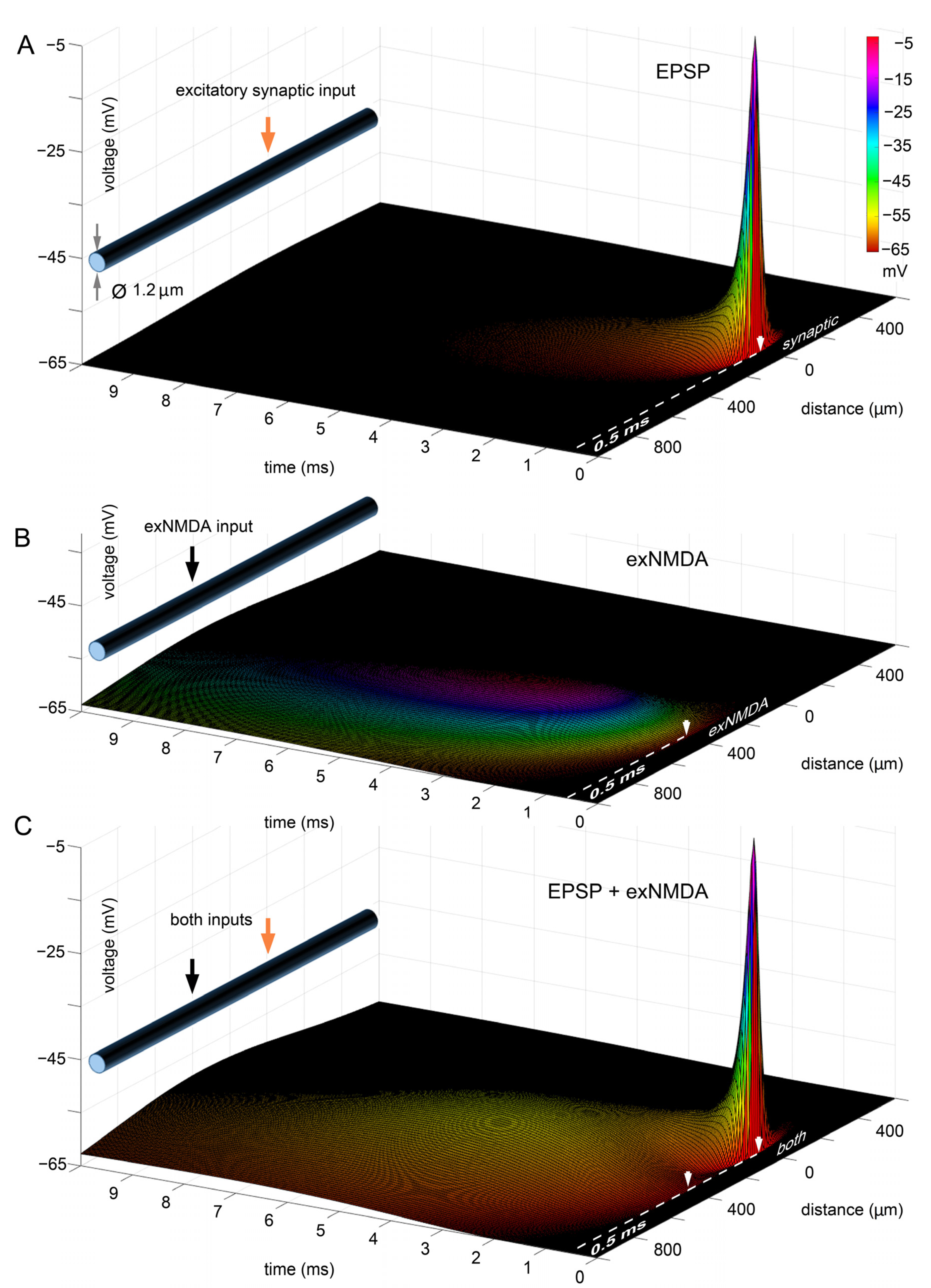

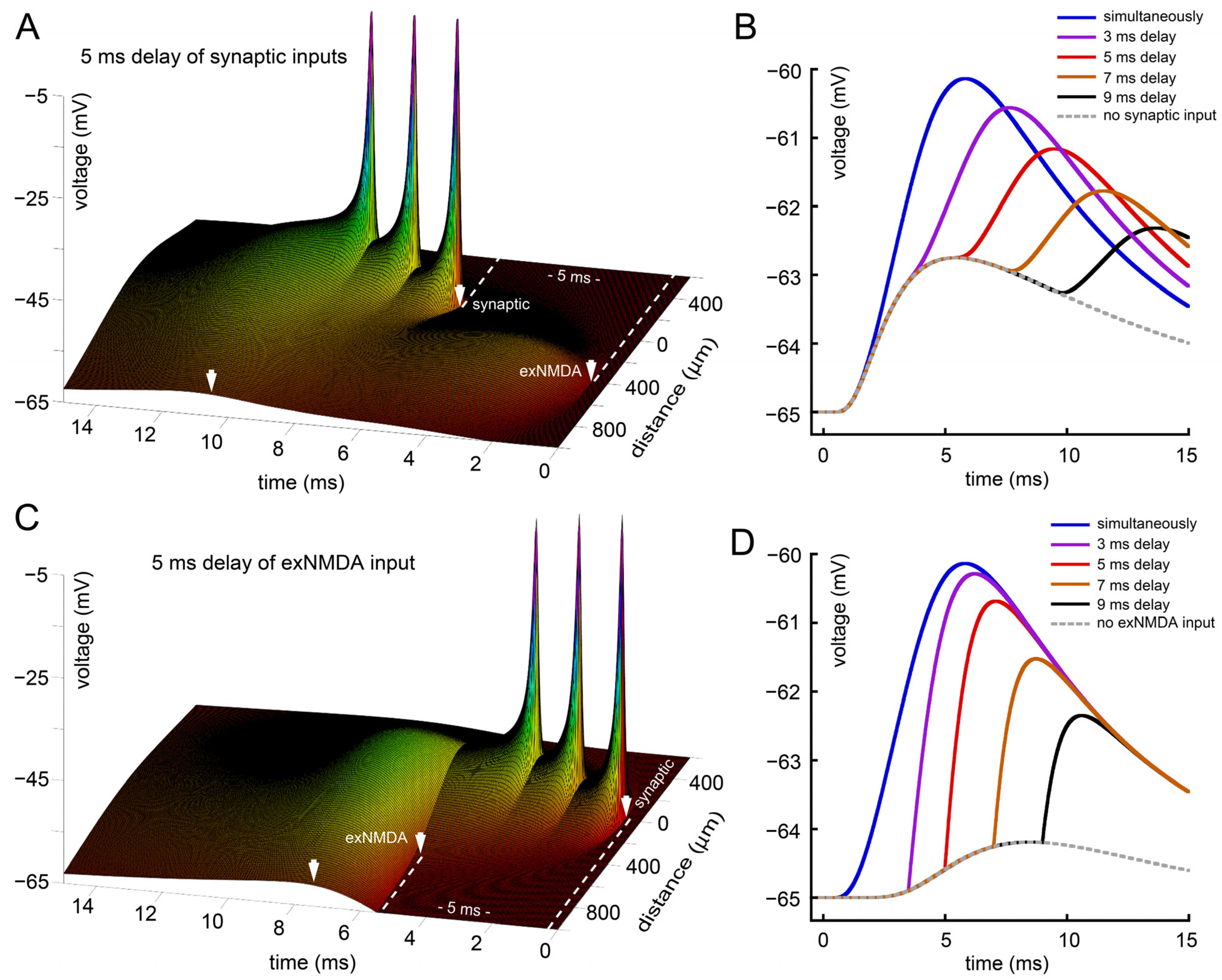

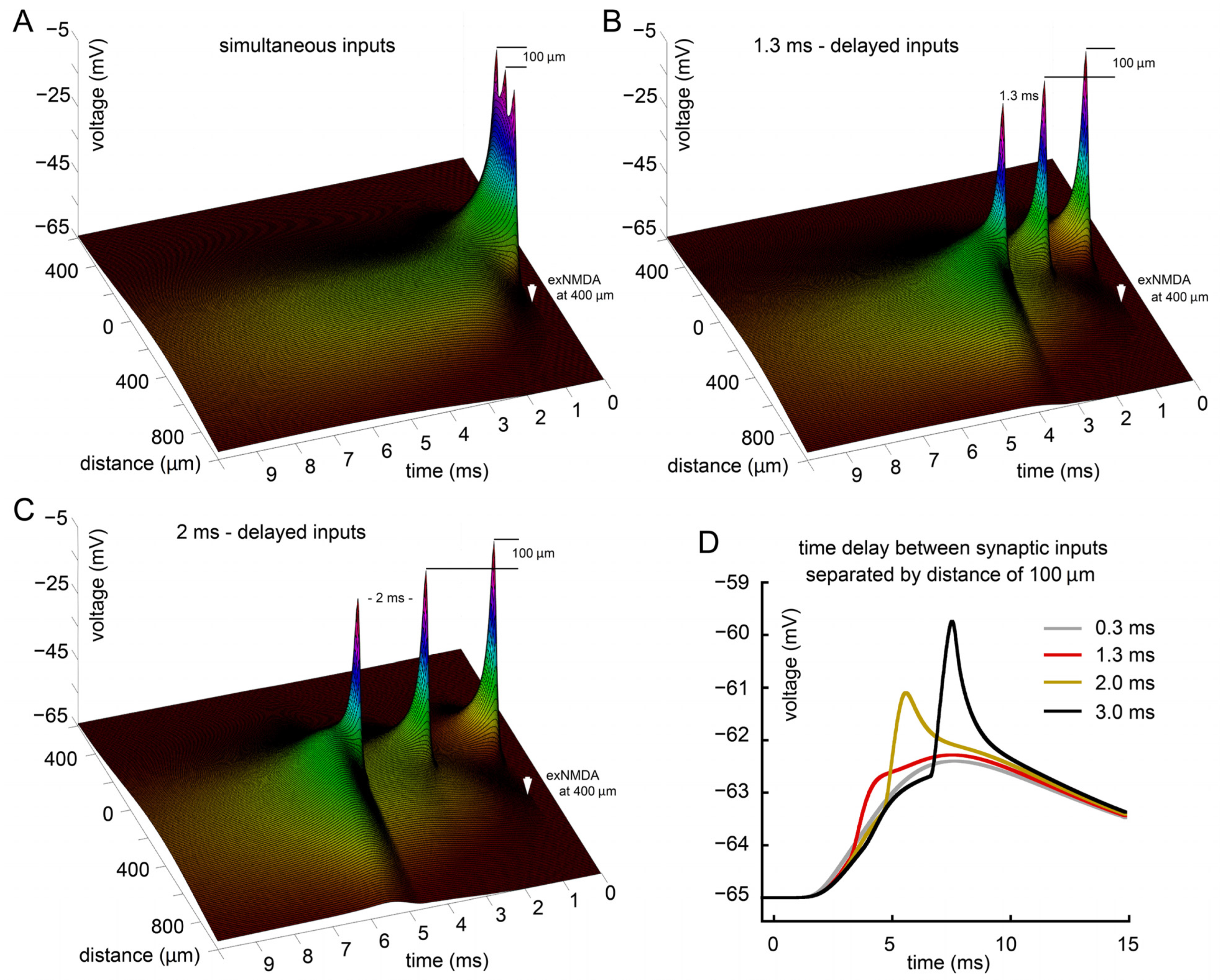

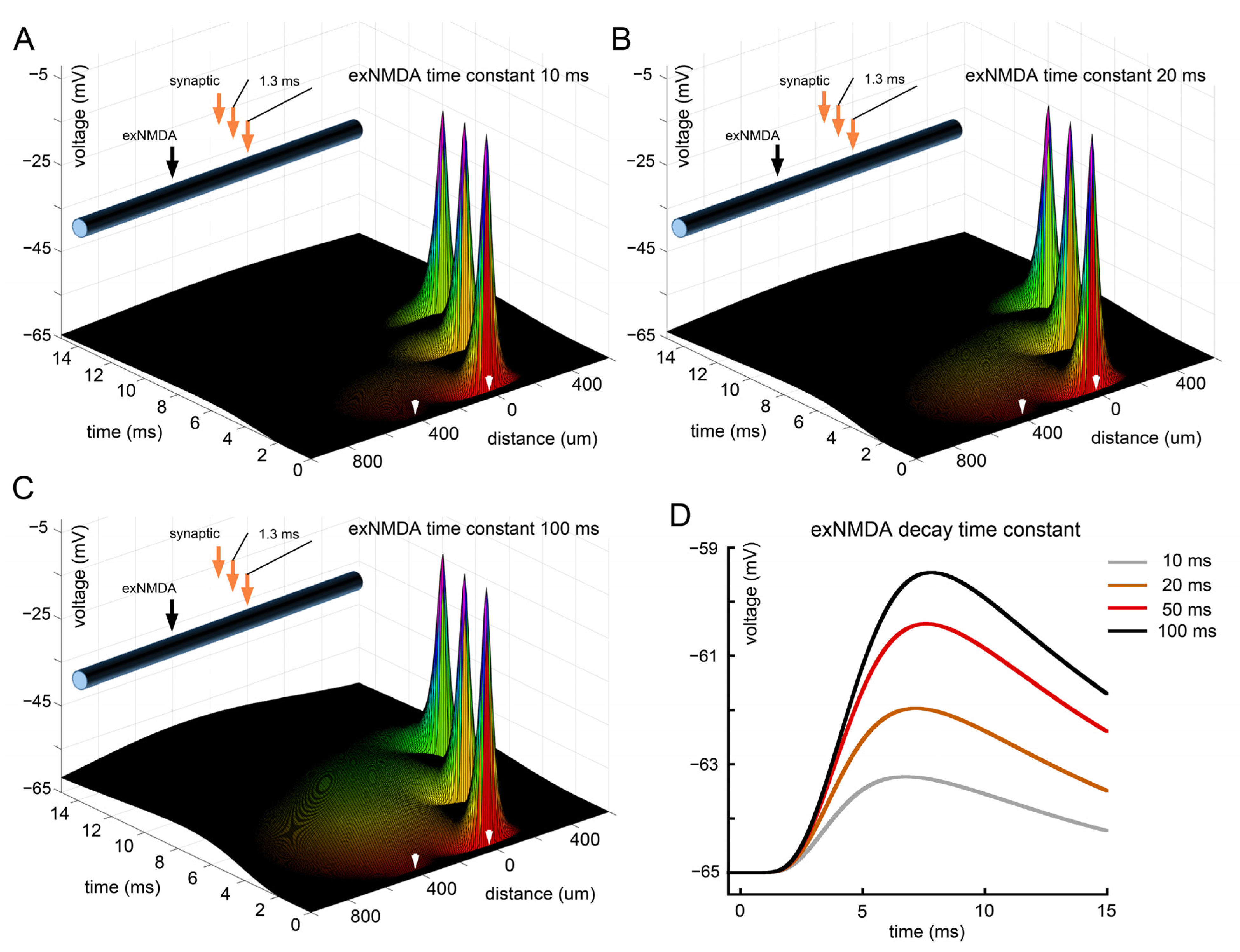
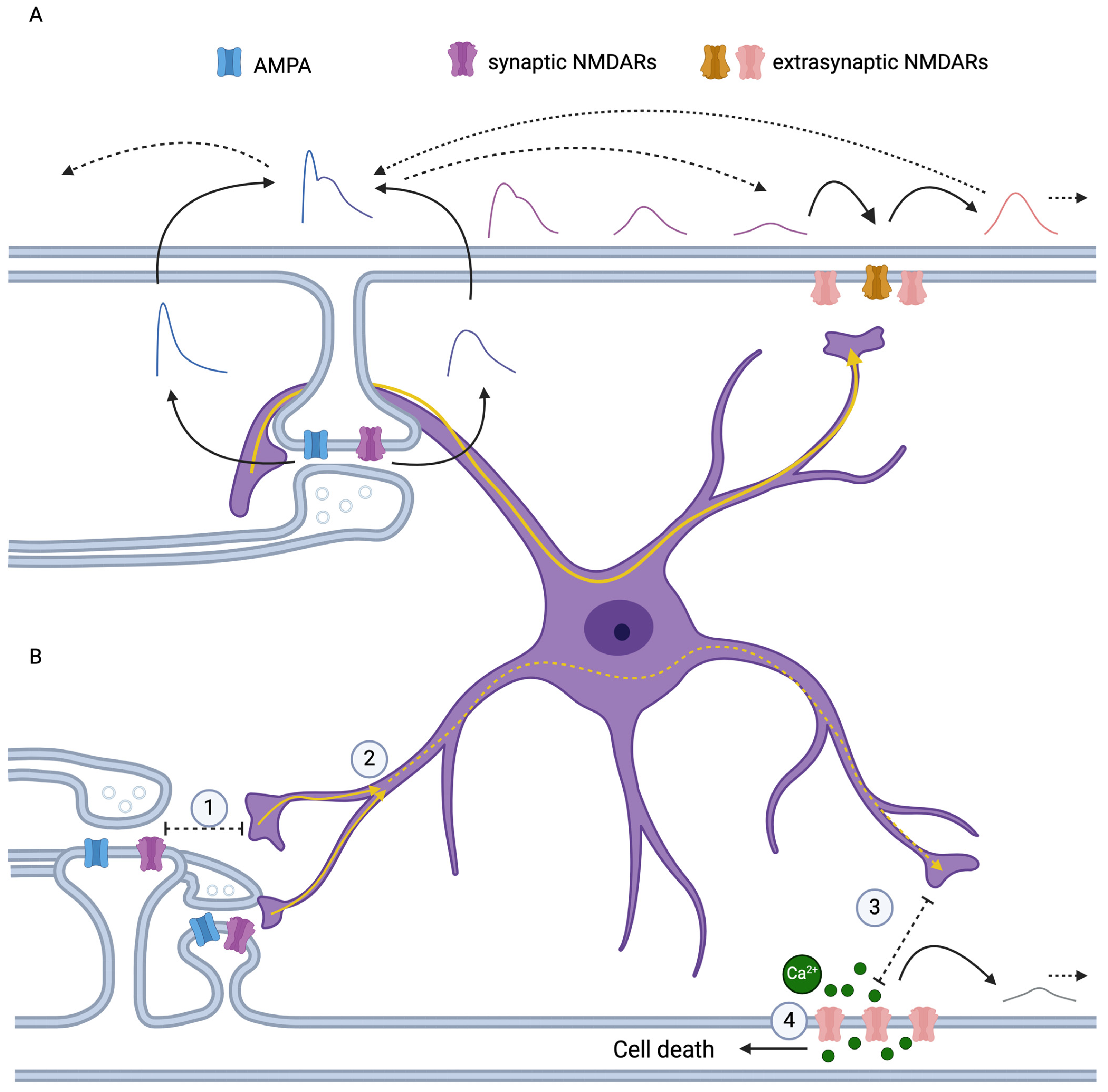
| Description | Value | References |
|---|---|---|
| [82,83] | ||
| [1,2,84] | ||
| * | ||
| [85] | ||
| * | ||
| [3,4] | ||
| [3,4] | ||
| [82,83] | ||
| [81] | ||
| * | ||
| * | ||
| [86] | ||
| [5,6] | ||
| [83] | ||
| [83] | ||
| [28] | ||
| 50–100 ms | [5,6] | |
| * | ||
| 100 Hz | [87] | |
| GΩ | [78,88] | |
| ** | ||
| * | ||
| [89] | ||
| [75] | ||
| GΩ | [75] | |
| *** | ||
| *** |
Disclaimer/Publisher’s Note: The statements, opinions and data contained in all publications are solely those of the individual author(s) and contributor(s) and not of MDPI and/or the editor(s). MDPI and/or the editor(s) disclaim responsibility for any injury to people or property resulting from any ideas, methods, instructions or products referred to in the content. |
© 2024 by the authors. Licensee MDPI, Basel, Switzerland. This article is an open access article distributed under the terms and conditions of the Creative Commons Attribution (CC BY) license (https://creativecommons.org/licenses/by/4.0/).
Share and Cite
Makarov, M.; Papa, M.; Korkotian, E. Computational Modeling of Extrasynaptic NMDA Receptors: Insights into Dendritic Signal Amplification Mechanisms. Int. J. Mol. Sci. 2024, 25, 4235. https://doi.org/10.3390/ijms25084235
Makarov M, Papa M, Korkotian E. Computational Modeling of Extrasynaptic NMDA Receptors: Insights into Dendritic Signal Amplification Mechanisms. International Journal of Molecular Sciences. 2024; 25(8):4235. https://doi.org/10.3390/ijms25084235
Chicago/Turabian StyleMakarov, Mark, Michele Papa, and Eduard Korkotian. 2024. "Computational Modeling of Extrasynaptic NMDA Receptors: Insights into Dendritic Signal Amplification Mechanisms" International Journal of Molecular Sciences 25, no. 8: 4235. https://doi.org/10.3390/ijms25084235
APA StyleMakarov, M., Papa, M., & Korkotian, E. (2024). Computational Modeling of Extrasynaptic NMDA Receptors: Insights into Dendritic Signal Amplification Mechanisms. International Journal of Molecular Sciences, 25(8), 4235. https://doi.org/10.3390/ijms25084235






